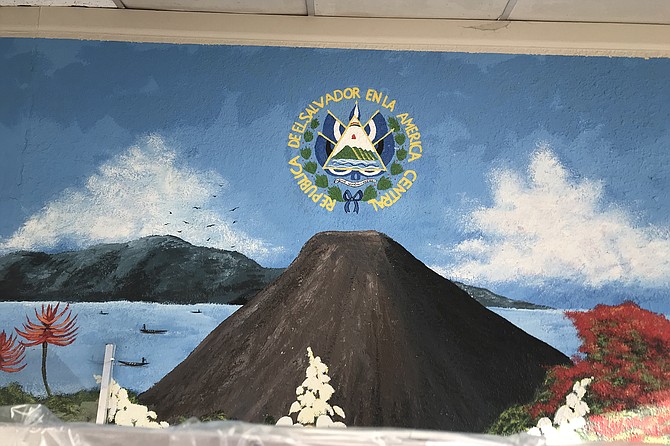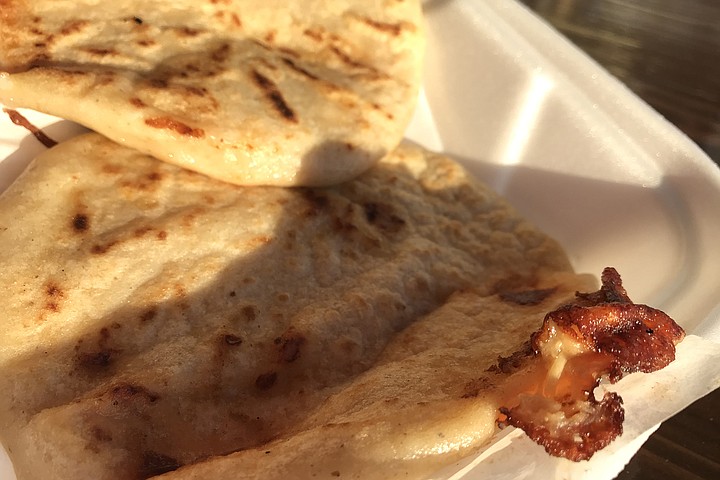 Facebook
Facebook
 X
X
 Instagram
Instagram
 TikTok
TikTok
 Youtube
Youtube

Argentina? El Salvador? Empanadas? Pupusas? What’s the difference?
I’m wandering, wandering, and wondering as I wander. I’ve just come down from City College. Had this crazy notion that their cafeteria might be open. What I found instead was an orange and black kaleidoscope of butterflies drinking from all the flowers of the college’s abandoned wild garden, and flying and flirting with each other. No humans! Felt a little post-apocalyptic.
Whatever, I’m kinda relieved to make it out to this bunch of eateries down on 10th and C. And the yellow one with the Argentinian comfort food hits the spot. Empanada Kitchen. I’ve been here before, but forgot how beautifully they bake their “rope”-enclosed empanadas. Golden, almost crunchy, but not overpowering the filling inside. I end up getting three. The beef, because cattle of the pampas is what Argentina’s all about, but then one with mushroom and goat cheese, and another with sweet corn and basil. Goodness, each of them is delicious. The basil really tweaks the sweet corn, and the flavor of the mushrooms with the twangy goat cheese has me swearing to come back and explore more.
Two days later, I’m down in National City, standing in front of a Salvadoran pupuseria. Silvia’s. Hits me: really, what’s the difference between an empanada from Argentina and a pupusa from El Salvador? They’re both kind of bready stuff wrapped around different fillings. Of course a pupusa’s “bread” is usually cornmeal, but it’s still got interesting things stuck in between the wrap.

We’re at the Highland View Center on East 8th Street. Pupuseria Silvia looks closed, like so many of the other places here, but no. People are eating at a couple of the tables set up outside. I head in. The inside tables have all been enclosed behind plastic curtains, except nobody’s sitting there. “Solo para llevar,” says a sign. “Only take-out.” But the guy at the counter, Raul, says we can eat outside.
So first, I’ve got to test my empanada/pupusa theory. “Authentic Salvadoran food,” says the menu.
These are ancient foods. I heard pupusas (“swollen bread” might be a good translation) came from the Pipil people, the ancient folks who lived where El Salvador is today. They usually filled their pupusas with cheese and frijoles, but also the flower of the loroco plant, chicharron (the Salvadoran version, pork paste, not the Mexican pork rinds); revuelta, meaning a mix of beans, cheese, and pork paste; and alongside, curtido, the sauerkraut/kimchi of El Salvador that always comes with pupusas.
The menu says they have stuffings such as spinach, pepperoni with cheese, fish, potatoes, calabaza (winter squash), cactus, broccoli and hongo (mushrooms). Cost $2.50 each, except for fish. That one’s $2.75.
So the question is, if they have burritos, omelets, tacos, tamales — and they do — why go for pupusa?

Because pupusa is so-o Salvadoran. And this little country is so steeped in the lore of ancient America, ya just gotta sink your teeth into its history. The Salvadoran government even made the pupusa El Salvador’s national dish in 2005.
But which pupusa?
“The chicharron. I have it every time,” says this guy John. He’s Salvadoran-American, in the line ahead. Turns out he’s from Texas. Navy dental assistant (“so everyone’s nice to me”).
Hmm.
When it’s my turn, I start with a drink, horchata, that’s as much Mexican as Central American, with its milky vanilla flavor actually derived from rice (50 cents). It’s another majorly historical item. The Muslim Moors brought it to Spain 1000 years ago, so we’re drinking history here. Then I choose the revuelta, because it’s that mix of cheese, beans and chicharron. Dang it, I completely forget to ask for that other Central American classic stuffing, the flowers of the loroco plant. I just ask for one stuffed with papas. Potatoes. Because now I’m distracted by this other dish I have to ask for: yuca frita. It’s a whole bunch of cubed, sautéed pork, with curtido, and most importantly, fried yuca. You wanna talk ancient? People around here have been domesticating and eating yuca (manioc, tapioca, whatever), for the past ten thousand years. So I order that, too. Costs $7.99 with a bit of salad.

I head out, sit down at a polished wooden table. Get talking to John. He says this Salvadoran food is better than in Texas. “Up here, it’s more mom and pop, family-style, hand patted. Down in Texas, it’s more industrial.”
Raul turns up with my pupusas, and the plate of yuca frita. And I do see how uneven and hand-shaped the pupusas look — just like the Pipil people made it back in the day, I’m guessing.
The pupusas feel and taste like comfort food. And now I think of it, that’s how it has always been: the further south you go, the hotter the weather, the tamer the food gets. None of the scalding peppers from Mexico’s El Norte. But I like it. And I like the crispy-fried yuca root. It really has a neutral taste that works well with the savory chunks of marinated pork. Again, the curtido’s here to clean out your mouth.
Sun’s setting. Our colony of eaters sits huddled against Silvia’s windows. We’re serious about chomping down while the sun’s still lighting and warming the place.
And the war between empanadas and pupusas? Turns out Salvadorans make their own empanadas. The difference? Guess I’ll have to come back on that one.


Argentina? El Salvador? Empanadas? Pupusas? What’s the difference?
I’m wandering, wandering, and wondering as I wander. I’ve just come down from City College. Had this crazy notion that their cafeteria might be open. What I found instead was an orange and black kaleidoscope of butterflies drinking from all the flowers of the college’s abandoned wild garden, and flying and flirting with each other. No humans! Felt a little post-apocalyptic.
Whatever, I’m kinda relieved to make it out to this bunch of eateries down on 10th and C. And the yellow one with the Argentinian comfort food hits the spot. Empanada Kitchen. I’ve been here before, but forgot how beautifully they bake their “rope”-enclosed empanadas. Golden, almost crunchy, but not overpowering the filling inside. I end up getting three. The beef, because cattle of the pampas is what Argentina’s all about, but then one with mushroom and goat cheese, and another with sweet corn and basil. Goodness, each of them is delicious. The basil really tweaks the sweet corn, and the flavor of the mushrooms with the twangy goat cheese has me swearing to come back and explore more.
Two days later, I’m down in National City, standing in front of a Salvadoran pupuseria. Silvia’s. Hits me: really, what’s the difference between an empanada from Argentina and a pupusa from El Salvador? They’re both kind of bready stuff wrapped around different fillings. Of course a pupusa’s “bread” is usually cornmeal, but it’s still got interesting things stuck in between the wrap.

We’re at the Highland View Center on East 8th Street. Pupuseria Silvia looks closed, like so many of the other places here, but no. People are eating at a couple of the tables set up outside. I head in. The inside tables have all been enclosed behind plastic curtains, except nobody’s sitting there. “Solo para llevar,” says a sign. “Only take-out.” But the guy at the counter, Raul, says we can eat outside.
So first, I’ve got to test my empanada/pupusa theory. “Authentic Salvadoran food,” says the menu.
These are ancient foods. I heard pupusas (“swollen bread” might be a good translation) came from the Pipil people, the ancient folks who lived where El Salvador is today. They usually filled their pupusas with cheese and frijoles, but also the flower of the loroco plant, chicharron (the Salvadoran version, pork paste, not the Mexican pork rinds); revuelta, meaning a mix of beans, cheese, and pork paste; and alongside, curtido, the sauerkraut/kimchi of El Salvador that always comes with pupusas.
The menu says they have stuffings such as spinach, pepperoni with cheese, fish, potatoes, calabaza (winter squash), cactus, broccoli and hongo (mushrooms). Cost $2.50 each, except for fish. That one’s $2.75.
So the question is, if they have burritos, omelets, tacos, tamales — and they do — why go for pupusa?

Because pupusa is so-o Salvadoran. And this little country is so steeped in the lore of ancient America, ya just gotta sink your teeth into its history. The Salvadoran government even made the pupusa El Salvador’s national dish in 2005.
But which pupusa?
“The chicharron. I have it every time,” says this guy John. He’s Salvadoran-American, in the line ahead. Turns out he’s from Texas. Navy dental assistant (“so everyone’s nice to me”).
Hmm.
When it’s my turn, I start with a drink, horchata, that’s as much Mexican as Central American, with its milky vanilla flavor actually derived from rice (50 cents). It’s another majorly historical item. The Muslim Moors brought it to Spain 1000 years ago, so we’re drinking history here. Then I choose the revuelta, because it’s that mix of cheese, beans and chicharron. Dang it, I completely forget to ask for that other Central American classic stuffing, the flowers of the loroco plant. I just ask for one stuffed with papas. Potatoes. Because now I’m distracted by this other dish I have to ask for: yuca frita. It’s a whole bunch of cubed, sautéed pork, with curtido, and most importantly, fried yuca. You wanna talk ancient? People around here have been domesticating and eating yuca (manioc, tapioca, whatever), for the past ten thousand years. So I order that, too. Costs $7.99 with a bit of salad.

I head out, sit down at a polished wooden table. Get talking to John. He says this Salvadoran food is better than in Texas. “Up here, it’s more mom and pop, family-style, hand patted. Down in Texas, it’s more industrial.”
Raul turns up with my pupusas, and the plate of yuca frita. And I do see how uneven and hand-shaped the pupusas look — just like the Pipil people made it back in the day, I’m guessing.
The pupusas feel and taste like comfort food. And now I think of it, that’s how it has always been: the further south you go, the hotter the weather, the tamer the food gets. None of the scalding peppers from Mexico’s El Norte. But I like it. And I like the crispy-fried yuca root. It really has a neutral taste that works well with the savory chunks of marinated pork. Again, the curtido’s here to clean out your mouth.
Sun’s setting. Our colony of eaters sits huddled against Silvia’s windows. We’re serious about chomping down while the sun’s still lighting and warming the place.
And the war between empanadas and pupusas? Turns out Salvadorans make their own empanadas. The difference? Guess I’ll have to come back on that one.